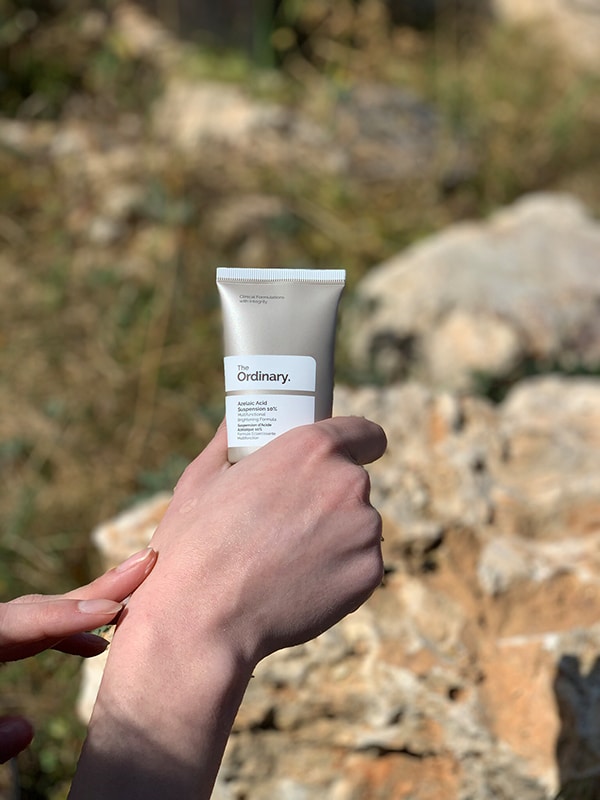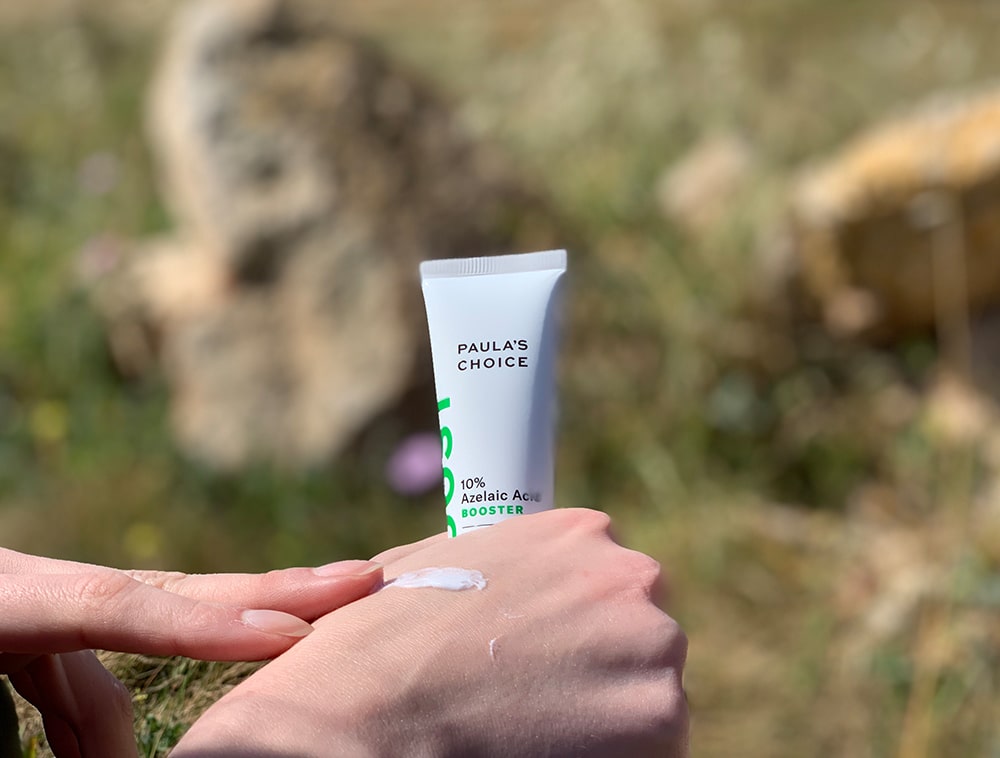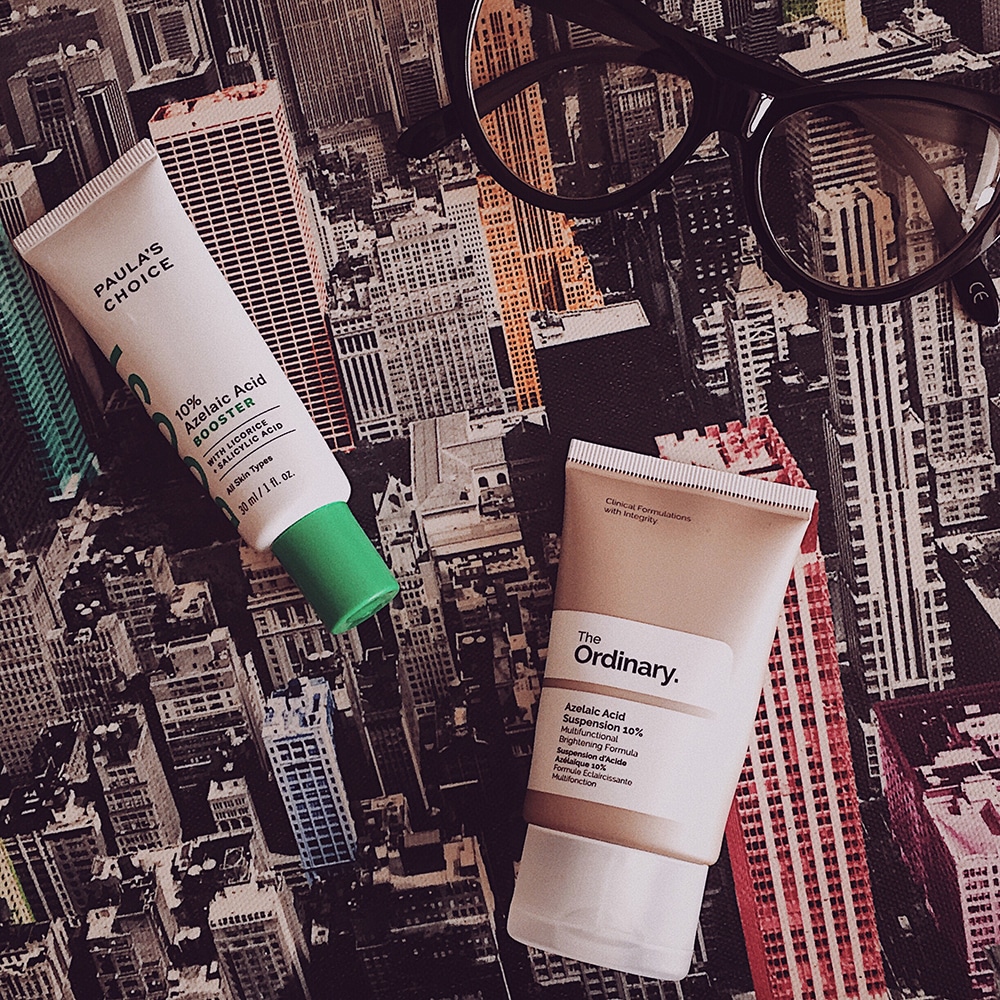Last updated on 14th June 2020 by Sarah Sarsby

Aesthetician Simone from The Skincare Culture is back with another great guest post all about how to improve uneven skin texture.
Simone’s first guest post on my site was about how to do a spa facial at home in 8 easy steps, which is very relevant given the current coronavirus pandemic. I love sharing Simone’s content as she’s an aesthetician, which means she can explain how different ingredients work on the skin and the results they might yield.
Although I don’t suffer from uneven skin texture anymore, it was definitely my biggest skincare nemesis for numerous years. This post is really helpful at breaking down what uneven skincare texture is, why it occurs and how you can improve skin texture.
I’d like to say a big thanks to Simone for writing this in-depth article for my blog and I hope you learn just as much as I did from reading this post.
About The Skincare Culture
Coping with acne breakouts made me endeavour and find a solution to my problem, also inspiring me to pursue a career in this beautiful and rewarding industry. I’m a certified esthetician and my goal with creating my blog – The Skincare Culture – is to educate my readers on how to take care of their skin.

Despite the common skin concerns that typically include acne, dryness, or excessive oiliness, sometimes our skin has a way of presenting new issues you didn’t even know existed.
These may include underlying issues that have just been waiting for the right time to present themselves on the surface, however, chances are that most of the time we don’t even know how to explain the things we see on our skin that bother us.
Let’s take skin texture as one example. Nope, this is not the same as uneven skin tone, which typically deals with the pigmentation of your skin, but rather the feel or smoothness of your overall complexion.
Although it might not be as well-known or talked about, uneven skin texture is just as common as uneven skin tone. But, where does this come from? And what is the reason behind having uneven skin texture? But most importantly, can you improve skin texture?
Let’s dive into this article and suggest several solutions that will help you tackle this peculiar skin concern with ease.
Why is my skin texture so bumpy?
Our skin is the biggest organ system in our bodies that has an important function to protect the body from external aggressors present in the environment that may cause harm.
The outermost layer of our skin is called the epidermis and is made up of five layers on its own. Now, the outermost layer of the epidermis is called stratum corneum and it consists of a series of layers of specialised skin cells that are continually shedding.
These skin cells are also known to us as dead skin cells and they serve as the primary barrier between the body and the environment. So, as we already mentioned, these dead skin cells are continually shedding in a process we know as desquamation.
However, this process typically slows down with ageing, which means that the dead skin cells are going to remain on the surface of your skin for longer.
The dead skin cells serve an important role in protecting us, however, they may very well be the main troublemaker if not maintained.
Which brings us to uneven skin texture. Uneven skin texture is one common result of excess dead skin cells that build up on the surface of the skin.

These can make areas of the skin feel rough or bumpy to the touch and can also give the skin a somewhat dull appearance. But dead skin cells are not the only factor contributing to uneven skin texture.
The environment also plays a key role in this particular skin concern, including the dirt, pollution, chemicals, and the aggressive sun rays that work around the clock to negatively affect our skin.
These factors can also contribute to the disruption of collagen and elasticity, which is yet another key factor in having uneven skin texture.
As we age, the production of collagen in the body decreases, thus causing the skin cells to lose the ability to retain smooth texture, firmness, moisture, and tone.
Moreover, severe acne breakouts may potentially lead to visible, so-called “pitted” scars on the skin which are technically another case of uneven skin texture.
So, why is my skin texture so bumpy?
As it turns out, there are many factors that can contribute to this skin concern.
When trying to answer this question, you need to consider your skincare habits, the products you are using, how well are you protecting your skin from external aggressors, your age, as well as your skin’s history.
How do you refine skin texture?
As identified above, there are several things that could be causing unwanted skin texture, therefore, there are things that you can do to minimise and get rid of it.
First and foremost, the most important thing is to pay attention to your skincare habits as your skincare products may not be doing you any favours when it comes to skin texture.
Consider the following solutions:
A gentle cleanser that won’t dehydrate your skin
Cleansers are intended to remove the buildup of daily pollution on the skin and things like makeup, grime or any skincare products that are still lingering on the skin from the night before.
However, cleansers also have the potential to contribute to uneven skin texture if they consist of harsh and overly stripping ingredients.
Ingredients such as sodium lauryl sulfate (SLS) which is essentially a crystalline salt of sulfated lauryl alcohol is good at general cleaning because it is a good surfactant, however, it is known to be a common irritant as it has the ability to dehydrate and strip the skin of its essential moisture.
On the other hand, using cleansers that contain alpha hydroxy acids or beta hydroxy acids may not be the best option as these too can act as an overly stripping agent on the skin.
AHAs and BHAs are excellent ingredients on their own and you should definitely implement them in your skincare routine, but certainly not in a cleanser form.
These ingredients need their sweet time to do what they are supposed to do, so having them in a cleanser that you are going to rinse off after a few seconds is pretty useless and potentially damaging for the skin.

Regular exfoliation is important
Now, this is where you should consider opting for an AHA or BHA as regular exfoliation, which contributes to every good skincare routine. Regular exfoliation removes the buildup of dead skin cells on the surface of the skin, thus revealing a brighter and smoother complexion. You could try the ARK Skincare Triple Action Exfoliator, which I’ve been loving recently.
Regular exfoliation will definitely help you get rid of uneven skin texture over time, depending on what caused the texture in the first place.
Don’t ignore moisturising
A good moisturiser will hydrate and plump your skin, thus minimising the appearance of uneven skin texture. Moisturised skin is healthy skin, so don’t be afraid to give it the much-needed moisture.
This will not only plump uneven skin texture but will also contribute to that healthy glow we are all trying to achieve.
In-office treatments
Perhaps considering a professional treatment, such as a chemical peel or a micro-needling session, will be a great option for getting rid of uneven texture.
Chemical peels are essentially AHAs and BHAs with a higher strength than products we have access to over-the-counter. These are done by professional aestheticians and aim to remove the buildup of rough skin, dead skin cells, and get rid of uneven skin texture.
Microneedling, on the other hand, is another effective treatment for improving the appearance of scars and skin texture. The micro-needles penetrate the skin, triggering the body’s own wound healing response which essentially results in collagen production, which is stronger and firmer than before.
What products are good for textured skin?
If your concern is mild, you can certainly find over-the-counter products that are super-effective when it comes to getting rid of uneven skin texture at home.
Here are some ingredients that can have a great effect on minimising or fully getting rid of texture:
Azelaic acid
Azelaic acid is, in my opinion, an extremely underrated ingredient that has a huge potential of minimising uneven skin texture among targeting other skin concerns.
Naturally derived from wheat, grains and barley, azelaic acid helps brighten the skin tone and visibly improve the evenness of skin texture.
Furthermore, it is also very efficient in targeting blackheads and even acne. It is also very mild and it is unlikely that it will give you an adverse effect or an unwanted skin reaction. It is the one ingredient you can’t go wrong with.

Glycolic acid
Glycolic acid is the most common type of AHA and this is another powerhouse of an ingredient that offers many skin benefits.
It is naturally derived from sugar cane and it has the smallest molecular weight of all other alpha hydroxy acids, which makes it easy for it to penetrate the upper layers of the skin effectively and break the bonds between dead skin cells.
Glycolic acid is excellent for improving uneven skin texture with regular use and it can also work to minimise and completely get rid of hyperpigmentation, dullness, and even mild acne in some cases.
Hyaluronic acid
Even though it is called an acid, hyaluronic acid is the mildest form of “acid” out there. Think of hyaluronic acid like one big glass of water for your skin.
This ingredient is able to hold up to 1,000 times its molecular weight in water and it may also penetrate the skin to bind water to skin cells, infusing all layers of the skin with that much-needed moisture.
In addition to this, hyaluronic acid can be layered over and used in combination with other treatments without the risk of irritation. Furthermore, hyaluronic acid makes the skin look tighter and it can plump and smooth out the uneven texture you are trying to get rid of.
It is really a powerhouse ingredient that can help all skin concerns and skin types with regular use.
Final thoughts
Uneven skin texture may be caused by many factors but that doesn’t mean that it is something that cannot be completely treated. It is an annoyance, that’s for sure, however, a little bit of dedication will certainly take you a long way.
I would love to hear your opinions about this article. Do you have an uneven skin texture you are trying to improve? Or have you already cleared your uneven skin texture? If so, I would love to know how, so don’t hold back in that comment section.


I’ve heard great things about Paula’s Choice. The Azelaic acid sounds like a great ingredient, I need to check it out!
I agree! I didn’t know anything about it before but now I’m really intrigued
Thank you for posting my article, Sarah. I am always happy to contribute to your awesome blog and help readers solve their skin concerns with ease.
I am looking forward to future collaborations <3
Thanks for taking the time out to write this very in-depth and informative post! It’s great to be able to share your knowledge and experience on my blog. I also look forward to future collaborations 🙂
Such a great guest post by Simone (what a beautiful name 😉 ) and I also really love the pictures she took for this post!